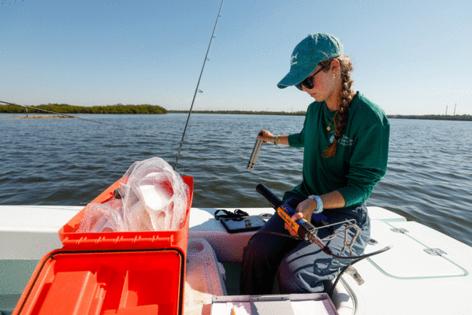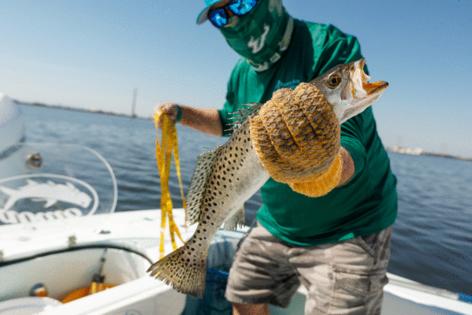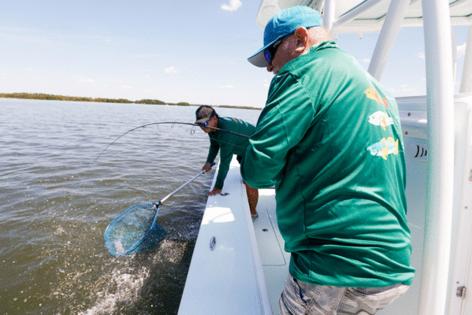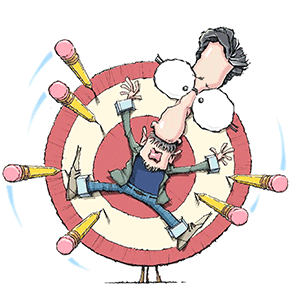What's contaminating Tampa Bay's fish? These scientists are angling for answers
Published in Science & Technology News
IN A BOAT OFF APOLLO BEACH, Fla. — A slow morning on the water erupted into a frenzy when the line began whizzing out of Steve Murawski’s fishing rod.
“I’m on!” Murawski yelled, scattering the boat’s crew into action.
A tan fish launched from the glassy, shallow water tucked in this hidden pocket of Tampa Bay mangrove forest. It was exactly the type of fish Murawski’s team of scientists came here to find:
Centropomus undecimalis, the common snook.
This one was a beauty. At 22 inches and with a jet-black line running horizontally across its body, Murawski proudly called his catch a “double bagger” — it would take two bags to store on ice.
The snook was the 681st fish caught by the Tampa Bay Surveillance Project, a sweeping research initiative that aims to study contaminants found in the bay’s most coveted fish species: spotted seatrout, redfish, sheepshead and snook. Fish No. 682 came minutes later, also a snook, in an equally riveting fight.
A handful of the region’s top recreational fishing charter captains have partnered with scientists from the University of South Florida’s College of Marine Science in St. Petersburg for the five-year, $3.4-million study funded by the National Oceanic and Atmospheric Administration to catch and sample the popular species along the shores of the estuary’s 400 square miles.
Researchers are focusing on the inshore fish most commonly caught for food, Murawski said, which is why studying their chemistry is so crucial. After scientists reel in a catch, they bring them ashore to test the fish in the university’s lab for a cocktail of contaminants, including pesticides, pharmaceuticals, a durable group of slow-to-break-down “forever chemicals” and more.
“Tampa Bay is one of the fishing hotspots of western Florida and the Gulf, so if there are any threats to consuming these fish, it’s important for us to know about them,” said Murawski, a professor of oceanography at the College of Marine Science and the project’s principal investigator.
“The animals that we’re catching are top predators,” Murawski said. “But the ultimate top predator is people. Are these chemicals being transferred at higher and higher levels of concentration? We think that’s true.”
Not only are researchers testing fish for pollutants, they also want to learn whether the people who fish in Tampa Bay for food are more at risk of contamination. A three-year, $750,000 National Science Foundation-funded survey of people in the region who fish for food should shed light on seafood-eating habits and help scientists come up with risk assessments for safer consumption, according to the project.
Matt Santiago, 41, has been fishing in the bay since he could walk, and he regularly eats the fish he catches. That’s why the professional charter captain of more than 17 years happily agreed to help the university’s researchers determine what’s fouling fish.
“Our industry is heavily dependent on the sustainability of our natural resources. We need to take good care of our water,” Santiago said. “The more information that we can gather about these chemicals, the better. It’s a really important thing.”
Plus, the project’s results could help local governments pinpoint where the bay’s pollution is coming from.
For instance, if a redfish caught in northern Tampa Bay has more pharmaceuticals, like opioids, in its system than a redfish caught in the bay’s southern end, that could signal there is a wastewater pollution problem in the northern bay. It’s difficult for treatment plants to filter out trace amounts of pharmaceuticals, so when humans urinate chemicals from the pills they ingest, that can ultimately end up in the bay.
Or perhaps a sheepshead, with its iconic black-and-white bars, is caught near a part of the estuary with a heavy agriculture footprint. The presence of pesticides in that fish could tell officials that more needs to be done to control rainfall runoff from area farms.
“This is not just a bellwether, it’s the largest open-water estuary in Florida,” Murawski said. “We ought to understand this pretty well... If we can help identify the source of some of these pollutants, it helps.”
The project is building on recent studies that have showed “potentially problematic” levels of pollution in Tampa Bay’s water, sediment and fish. The project should inspire other scientists looking to pinpoint pollutants in other large waterbodies, according to Murawski. The team should begin seeing results over the next year.
With the project now in its second year, students in Murawski’s lab have boated into the bay each week searching for fish. Tampa Bay has a broad mix of industries near its shores, from ports and cities to phosphate plants and agriculture, Murawski said. So to make sure scientists are capturing possible pollutants on a wide scale, they’ve divided the bay geographically into six segments.
The team’s goal is to catch 10 animals of all the desired species in each segment every season — or 960 fish each year, according to the project.
Spending so much time on the water, there’s no shortage of fish tales among the team: Alexandra Lee, a master’s student studying marine preservation and conservation, said there was one day last year when the team caught nearly 30 fish over a few hours.
Last week, researchers reeled in their biggest catch yet: a snook measuring an impressive 32 inches. The heaviest fish so far? A hunker of a redfish caught Aug. 12 last year weighing more than 121/2 pounds.
“When I joined this project, I knew I’d be working on contaminants in fish, but being in the field this much has been a pleasant surprise,” Lee said. “Not every researcher can be in the field all the time, and our project is so encompassing that we can be.”
With one or even two fishing trips a week, Lee estimates she’s been out on the water at least 30 times since research began last year.
She’s fished all over Tampa Bay, from the bluish green waters on the east side of secluded Egmont Key to Manbirtee Key, a 60-acre dredge island near Port Manatee where ships barrel by in the channel.
The team has even been granted permission to study fish near MacDill Air Force Base, an area closed off to anglers. The fish population there is an interesting case study in what the fishery looked like decades ago, with little human interaction, according to researchers.
On the recent outing into Hillsborough Bay, the team caught three trout and three snook. The morning after, students in Murawski’s lab convened in the university’s marine science lab to dissect the fish and collect samples.
Kylee Rullo, a Ph.D. student in Murawski’s lab, held up a stony piece of white bone pulled from a dissected snook. Scientists call this an otolith, or the fish’s ear bone. You can learn a lot from an otolith, Rullo explained: Like counting rings in a tree, you can determine a fish’s age and growth rate.
A few rooms down the hall, scientists use a row of humming, expensive devises like a mass spectrometer to sort ultra-small particles and help paint a clearer picture of the chemical makeup in each fish species.
“What do these contaminants mean for our environment? What do they mean for people who are eating fish — and how does that influence their health and their decision-making?" Lee said.
“We just really want to educate people.”
©2025 Tampa Bay Times. Visit tampabay.com. Distributed by Tribune Content Agency, LLC.












Comments